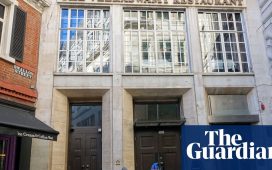This article is an on-site version of our Unhedged newsletter. Sign up here to get the newsletter sent straight to your inbox every weekday
Good morning. Did credit default swap shenanigans cause the sell-off in Deutsche Bank shares last Friday? Some central bankers in Europe think so. Luckily, markets have not given Deutsche the Credit Suisse treatment, in no small part because its business is stronger. But in panicky markets, it is easy to mistake noise for signal. Email us: robert.armstrong@ft.com & ethan.wu@ft.com.
The case for (some) calm on commercial real estate
The reason to care about commercial real estate (CRE), even if you don’t invest in it directly, is that it is big and levered. Trouble in a $20tn market backed by a lot of debt matters to the whole financial system. Real estate lenders fund other assets too — and are themselves leveraged. Post-Silicon Valley Bank and with rates still rising, it is natural that this asset class should come in for scrutiny.
We’ve written about CRE several times recently and, to our surprise, have come out of the exercise less alarmed than when we started. There are real reasons for worry: offices are getting pummeled and banks will eat those losses. Outside of offices, too, valuations look overextended. In a correction, some regional lenders could be exposed. But as a proverbial next shoe to drop, we aren’t yet panicked about CRE.
Start with the scariest bit. Valuations look very stretched and a reversion to the mean suggests a harsh correction. The chart below shows cap rates, a property’s net operating income (revenue minus operating expenses) divided by its market value, as a spread over the 10-year yield. Think of it like the equity risk premium, an extra bit of compensation you get for taking risk on stocks or, in this case, commercial property. Across segments, CRE is not paying much these days:

The chart above is busy; zooming in on one property type helps. Here are cap rate spreads for commercial apartment buildings, which are around pre-great financial crisis lows and well below historical averages:

This is not surprising after the blitz of a tightening cycle we’ve just witnessed. Higher rates have dragged down spreads-over-Treasuries in all kinds of asset classes. In theory, cap rate spreads could mean-revert through either falling property prices or rising net operating incomes (or both), but landlords can only raise rents so much without driving away tenants. Unless rates fall drastically, many CRE-watchers expect the price correction that began in December to continue — likely at a tortuously slow pace, thanks to depressed transaction volumes. We showed you this chart last week:

This isn’t just offices; a property type price breakdown shows year-over-year declines in all segments but industrial.
Falling prices, however, are not nearly as worrisome as defaults. And outside of offices, fundamentals seem sturdy enough. Distress remains rare. Unlike in the CRE bust of the early 1990s, when loan-to-value ratios were treacherously high, regional banks’ CRE loans have an average LTV around 66 per cent, according to MSCI Real Assets. Offices’ soaring vacancy rates are not showing up elsewhere. With the possible exception of recession-exposed retail, net operating income growth looks healthy (though this is somewhat exaggerated by inflation):

During the great financial crisis CRE prices fell 30 per cent, and this did not translating to widespread CRE borrower distress, argues Cathy Marcus, global chief operating officer at PGIM Real Estate. She told Unhedged:
There was a very similar discussion during the GFC about the maturity wall, particularly in [commercial mortgage-backed securities]. There was this expected distress constantly. It just never happened. It never happened because it isn’t all happening at one time, it’s very diverse, there are a lot of different types of lenders . . . So I don’t know that I’m that concerned.
So how much distress is coming, and can lenders, particularly regional banks, weather it?
JPMorgan’s credit research team recently simulated a CRE stress test on regional banks. They assume that banks take a 9 per cent loss on their total office exposure and 6 per cent on retail, spread over three years. The analysis uncovers some chunky losses at a handful of regional lenders. But even in the worst modelled case, a $5bn New Jersey lender called (no joke) Valley National Bank, losses are expected to cut its tier 1 equity capital ratio from 9 per cent to 8.7 per cent — hardly a solvency crisis. The JPMorgan analysts conclude:
The biggest issue for bank analysts is whether the exposure to office and retail be “an earnings event or a capital event”. We believe that at the end of day the impact will be about earnings, although we do highlight that our assumptions are sensitive to the duration of the losses.
Using a separate credit default risk model, Tom Tzitzouris and Brandon Fontaine of Strategas (who are more alarmed about CRE) reach a similar conclusion. They consider the 25 banks with the highest CRE exposure and, excluding one outlier, find that even under “worst case” assumptions the expected probability of default is very low. They add the caveat:
We believe that CRE risk is just beginning to build. So while net interest margins and held to maturity portfolios are the predominant risks facing banks today, non-performing loans and loan-loss reserves could easily become the primary risks in the second half of the year.
The case for calm on CRE is that ex-office fundamentals are strong, near-term risks are contained and pain has been realised gradually in past crises. Lower interest rates, now the baked-in market expectation, would also be “much more accommodative of real estate”, adds Marcus, though she thinks a reckoning in offices is nearly certain.
Where we land is that a CRE downturn may well add to the broad set of profit pressures facing banks. It’s a less-exciting prediction than a 2008 rerun in CRE. But the accumulation of medium-sized stresses can still make a crisis, even if any particular stress can’t. (Ethan Wu)
Junk spreads
Everyone’s favourite credit-spread maven, Marty Fridson of Lehmann Livian Fridson Advisors, published a comment on Monday that caught our eye. He noted that despite a 1 percentage point widening in high-yield spreads in the first week of March, they remain historically tight relative to credit conditions.
In the latest Fed survey of bank loan officers, the net percentage tightening standards for business loans was 45 per cent; that figure was -15 per cent just a year ago. Tightening lending standards are relevant to default risk, and therefore credit spreads, because lots of loans have to be rolled over all the time. It’s when companies try to roll their debt and find they can’t do so affordably that they most often run into trouble.
Historically, Fridson points out, when the Fed survey is in the 40-50 per cent range, the median high-yield spread is 7.92 percentage points. Spreads are currently at 5.03. Even excluding recessionary periods, the historical median is 6.23.
Here’s our chart of the two, showing a big gap in what is usually a close relationship:
Note that the survey results date from January, before banking stresses came into bloom. As Fridson drolly noted, “it seems unlikely that banks have eased up on their lending standards since those events”.
Fridson told us that “if there is an explanation other than people just being deluded there is still seemly this holdover from quantitative easing.” That is to say: there is still lots of money floating that needs yield.
Greg Obenshain, who is head of credit at Verdad Capital, agrees. While credit spreads are going the right direction (wider) they still look thin relative to credit conditions, he thinks, adding that:
We also look at the level and direction of the high-yield spread, and when it’s above its long-term median and rising, that’s a bearish trend. That’s where we are right now . . . I’m positioned in short duration and relatively high quality high yield, where I can make money on the coupon even in a recession
That sounds sensible.
One good read
Shadow work is everywhere.











